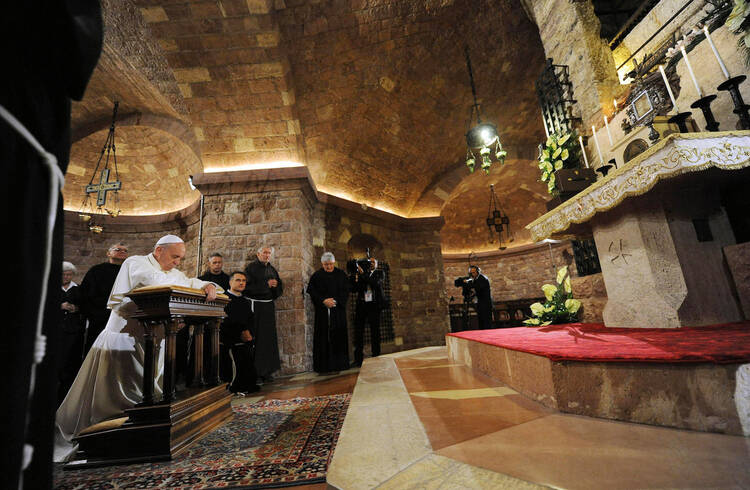Today is always a tremendous day for the Franciscan family. Beginning with the evening of October 3, during which the Franciscans celebrate the Transitus (the passing over) of St. Francis from this life to eternal life, through the Solemnity of October 4 the friars, sisters, secular Franciscans, and women and men with Franciscan hearts call to mind the life and legacy of the little poor man from Assisi with joy.
That Pope Francis, the first Bishop of Rome to take his name after the most-famous Saint in Christian history (after Mary, the mother of Jesus, of course), is spending this holy day in Assisi just makes the day all the more inspiring.
But it’s not just about Pope Francis’s visit to Assisi. No, there is very important significance to the schedule itself, something that might easily be overlooked by those less familiar with the life and history of St. Francis of Assisi.
Pope Francis flew in from the Vatican this morning and landed in a sports field at the Seraphic Institute of Assisi, a nonprofit organization that cares for disabled children in Italy. In an off-script address delivered there, the pope compared the wounds and physical disabilities of the children to the wounds of Christ – noting that it was in the wounds of Christ that his disciples recognized the presence of the Lord after his resurrection. An easily overlooked aspect of this first stop is the parallel with the journey of conversion in St. Francis’s life. It was through encountering the forgotten, despised, marginalized, and overlooked people of his time that first is so closely associated with the beginning of Francis’s life of conversion. Early biographies of the saint sometimes depict the leper as Christ. It is clear from Pope Francis’s remarks that the presence of Christ was recognized among these marginalized and too-often-forgotten children.
The next stop was to the church of San Damiano. This was where St. Francis famously heard the voice of Christ calling him to “Rebuild My Church.” It is also the location where Clare of Assisi and the early sisters lived and ministered. After recognizing Christ in those typically forgotten by society, the pope moved to a place where the vocation – the calling – of God to St. Francis is classically recalled. That this pastoral visit to Assisi follows immediately after three days of consultation with the new “Council of Cardinals,” the 8 Cardinals appointed by the pope as advisors from around the world, seems to tie naturally with the call Pope Francis seems to have received to, like the saint of the same name, “Rebuild My Church.”
The pope addressed a gathering of people from Assisi, including some of the local poor, at the home of the Bishop of Assisi in the hall best known as the location where St. Francis renounced his earthly inheritance, stripped off his clothes, and vowed to follow only his “Father in heaven.” Here we see the significance of renouncing the trappings of the world to embrace the service of God and creation.
Pope Francis visited the tomb of St. Francis, prayed at the earthly resting place of the man who did nothing other than live the Gospel life as authentically as he could. That radical and courageous, yet simple action on the part of St. Francis has nevertheless changed the church and world. There, outside the Basilica of St. Francis, Pope Francis celebrated the Eucharist with thousands.
Later in the day Pope Francis’s scheduled included stops at several significant locations in the life of Saints Francis and Clare, including the Cathedral church of San Rufino, where both Francis and Clare were baptized.
Finally, Pope Francis’s schedule has him ending his day at the church of St. Mary of the Angels, the Portiuncula, which is known as the “Mother Church” of the Friars Minor. It is the place where St. Francis asked to be brought as he laid dying in 1226. It is where he embraced “Sister Death” (as St. Francis said) and entered eternal life. This is the location where friars “return home” to recall the origins of our Order and way of life, and it is a sacred place of great significance and inspiration because it is the place that St. Francis is remembered to have loved more than any other on earth.
That Pope Francis has walked, in miniature, the life of the saint he so admires and sees as the model for all Christians, is not to be overlooked. St. Francis’s original journey along this path shaped Christian history irrevocably for the better. May Pope Francis’s journey today do the same.
Daniel P. Horan, O.F.M., a columnist for America, is the author of several books, including most recently the forthcoming The Last Words of Jesus: A Meditation on Love and Suffering.








